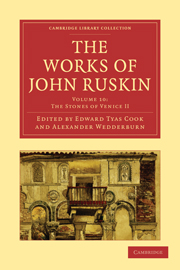Book contents
- Frontmatter
- Contents
- LIST OF ILLUSTRATIONS
- INDEX TO THE ILLUSTRATIONS
- INTRODUCTION TO THIS VOLUME
- BIBLIOGRAPHICAL NOTE
- The Stones of Venice, Vol. II. (CONTANING THE TEXT OF ALL THE EDITIONS)
- FIRST, OR BYZANTINE, PERIOD
- CHAP. I THE THRONE
- CHAP. II TORCELLO
- CHAP. III MURANO
- CHAP. IV ST. MARK'S
- CHAP. V BYZANTINE PALACES
- SECOND, OR GOTHIC, PERIOD
- AUTHORS APPENDIX
- Plate section
CHAP. IV - ST. MARK'S
Published online by Cambridge University Press: 05 November 2011
- Frontmatter
- Contents
- LIST OF ILLUSTRATIONS
- INDEX TO THE ILLUSTRATIONS
- INTRODUCTION TO THIS VOLUME
- BIBLIOGRAPHICAL NOTE
- The Stones of Venice, Vol. II. (CONTANING THE TEXT OF ALL THE EDITIONS)
- FIRST, OR BYZANTINE, PERIOD
- CHAP. I THE THRONE
- CHAP. II TORCELLO
- CHAP. III MURANO
- CHAP. IV ST. MARK'S
- CHAP. V BYZANTINE PALACES
- SECOND, OR GOTHIC, PERIOD
- AUTHORS APPENDIX
- Plate section
Summary
§ 1. “And so Barnabas took Mark, and sailed unto Cyprus.” If as the shores of Asia lessened upon his sight, the spirit of prophecy had entered into the heart of the weak disciple who had turned back when his hand was on the plough, and who had been judged, by the chiefest of Christ's captains, unworthy thenceforward to go forth with him to the work, how wonderful would he have thought it, that by the lion symbol in future ages he was to be represented among men! how woful, that the war-cry of his name should so often reanimate the rage of the soldier, on those very plains where he himself had failed in the courage of the Christian, and so often dye with fruitless blood that very Cypriot Sea, over whose waves, in repentance and shame, he was following the Son of Consolation!
§ 2. That the Venetians possessed themselves of his body in the ninth century, there appears no sufficient reason to doubt, nor that it was principally in consequence of their having done so, that they chose him for their patron saint. There exists, however, a tradition that before he went into Egypt he had founded the church at Aquileia, and was thus in some sort the first bishop of the Venetian isles and people. I believe that this tradition stands on nearly as good grounds as that of St. Peter having been the first bishop of Rome; but, as usual, it is enriched by various later additions and embellishments, much resembling the stories told respecting the church of Murano.
- Type
- Chapter
- Information
- The Works of John Ruskin , pp. 69 - 142Publisher: Cambridge University PressPrint publication year: 2010First published in: 1904

